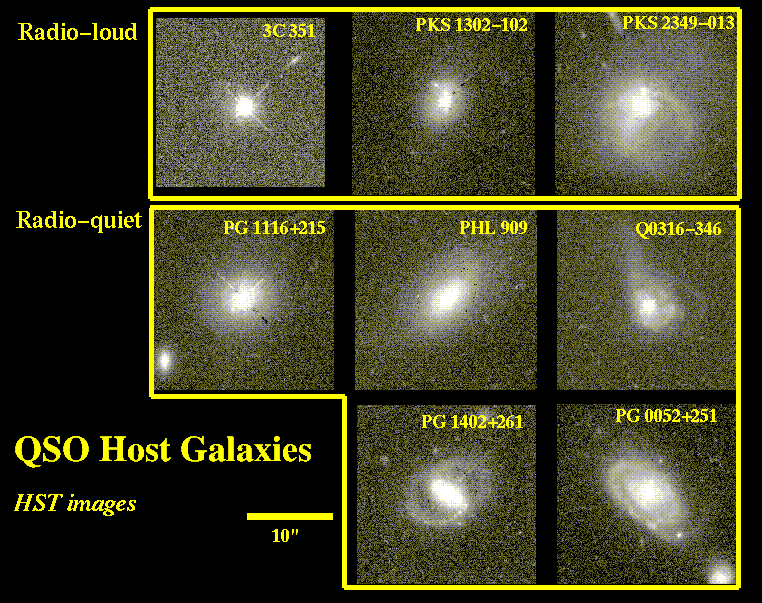
The search for the galaxies that quasars are imbedded in - the host galaxies - was long thought to be important, first, for establishing whether quasars are in fact as distant and luminous as we think they are, and second, for clues as to what can produce such an energetic phenomenon. By definition, typical ground-based telescopes don't see the surrounding galaxies against the quasar's intense light - if they did, we'd call it a Seyfert nucleus instead of a quasar. Impressive progress had been made from the best ground-based sites before the advent (and refurbishment) of HST, showing that many low-redshift quasars (the ones where we might expect to see a surrounding galaxy peeking around the edges of the blurred nuclear light) do in fact have fuzzy glows about the size and brightness of a decent galaxy, and in some cases it was even possible to measure the redshift of the surrounding galaxy from spectral features produced by their constituent stars. It had thus been established that many quasars do live in recognizable galaxies.
In most instances, though, the detection and detailed study of quasar host galaxies awaited the sharp images from HST, which could separate the brilliant nucleus from the faint glow of its host galaxy far more accurately than any other instrument. These images have revealed a great variety in size, brightness, and form of the galaxies. At one point there was a popular scheme, based on observations of nearby radio galaxies and Seyfert galaxies, suggesting that radio-loud quasars would live in elliptical galaxies and radio-quiet ones would be found in spirals. Only one part of this really works - radio-loud objects don't seem to be found in spiral galaxies. However, radio-loud and radio-quiet objects can be found in elliptical galaxies or merging systems, so the distinction isn't as clear-cut as we might have liked. One important pattern has emerged - a striking tendency for quasar host galaxies to have extraordinarily compact, close companion galaxies, which may fit with reports of a tendency for Seyfert and radio galaxies to show more signs of interaction than would be expected from chance.
The arrangement of objects here is intended to show parallel kinds of galaxies for radio-loud and radio-quiet QSOs where they have even found - including ellipticals, ellipticals with compact and close companions, and merging systems. The bottom two, spiral galaxies around radio-quiet nuclei, are not (yet) known to have counterparts for radio-loud quasars, so that this much of the analogy with Seyferts and radio galaxies seems to hold true. The objects shown here are at redshifts from z=0.155 (PG 0052+251) to z=0.371 for 3C 351.
Most of these data are from HST observations by John Bahcall, Sofia Kirhakos, and Donald Schneider, published in Astrophysical Journal 479, 642 (1997). They have subtracted a model for the quasar's own light in each case, based on observations of stars with the same filters, so that the much fainter surrounding details are more obvious. Using a contrasting approach centering on the higher resolution of the PC CCD, Peter Boyce and Mike Disney provided their image of 3C 351 as published by Disney et al. (Nature 376, 150, 1995). All are shown at the same angular scale, which for most of the quasars corresponds to a similar linear scale since they are concentrated at redshifts z=0.15 to 0.20.